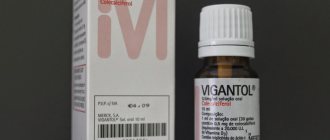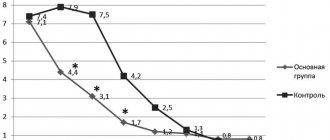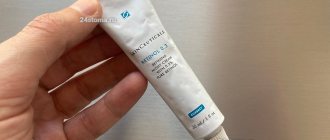Rinsulin® R
The dose of Rinsulin® R is determined by the doctor individually depending on the concentration of glucose in the blood. The drug can be administered subcutaneously and intravenously. For intravenous administration, either an insulin syringe or an infusion pump is used. The required dose of insulin is diluted in 0.9% sodium chloride solution. The dose and rate of administration are determined in accordance with clinical recommendations for the use of insulin in a hospital setting.
Mode of application
The drug is administered 30 minutes before meals.
The temperature of the administered drug should be at room temperature.
Subcutaneous injections should be done in the area of the shoulder, thigh, buttock or abdomen. Injection sites should be rotated so that the same site is used no more than approximately once a month. When injecting insulin subcutaneously, care must be taken not to enter a blood vessel when injecting. After the injection, do not massage the injection site. Patients should be trained in the correct use of the insulin delivery device.
The drug can be administered intravenously only under medical supervision.
Vials containing Rinsulin® R do not require resuspension and can only be used if their contents are a clear, colorless liquid without visible particles. Do not use the drug if a precipitate appears in the solution.
Always use an insulin syringe that matches the concentration of insulin being injected.
Instructions to be given to the patient
Do not use the drug if a precipitate appears in the solution.
Injection technique when using insulin in vials
If the patient is using only one type of insulin
1. Disinfect the rubber membrane of the bottle
2. Fill the syringe with air in a volume corresponding to the required dose of insulin. Inject air into the insulin vial.
3. Turn the bottle with the syringe upside down and draw the required dose of insulin into the syringe. Remove the needle from the vial and remove air from the syringe. Check that your insulin dose is correct.
4. Inject immediately.
If a patient needs to mix two types of insulin
1. Disinfect the rubber membranes of the bottles.
2. Immediately before drawing, roll the vial of long-acting insulin (“cloudy”) between your palms until the insulin becomes uniformly white and cloudy.
3. Fill the syringe with air in a volume corresponding to the dose of “cloudy” insulin. Inject air into the vial of cloudy insulin and remove the needle from the vial.
4. Fill the syringe with air in an amount corresponding to the dose of short-acting (“transparent”) insulin. Inject air into the vial of clear insulin. Turn the bottle with the syringe upside down and draw the required dose of “transparent” insulin. Remove the needle and remove air from the syringe. Check the correct dose.
5. Insert the needle into the vial with “cloudy” insulin, turn the vial with the syringe upside down and draw the required dose of insulin. Remove air from the syringe and check that the dose is correct. Immediately inject the collected insulin mixture.
6. Always draw insulins in the same sequence described above.
Injection procedure
— It is necessary to disinfect the area of skin where insulin will be injected.
- Use two fingers to gather a fold of skin, insert the needle into the base of the fold at an angle of about 45 degrees and inject insulin under the skin.
- After injection, the needle must remain under the skin for at least 6 seconds to ensure that the insulin is completely injected.
— If after removing the needle there is blood at the injection site, lightly press the injection site with a swab moistened with a disinfectant solution (for example, alcohol).
— It is necessary to change injection sites.
Rinsulin R
Release form, composition and packaging
The solution for injection is clear, colorless or almost colorless.
1 ml.
soluble insulin (human genetically engineered) 100 IU
Excipients: metacresol, glycerol, water for injection.
Clinical and pharmacological group: Short-acting human insulin.
pharmachologic effect
Short-acting human insulin produced using recombinant DNA technology. Interacts with a specific receptor on the outer cytoplasmic membrane of cells and forms an insulin-receptor complex that stimulates intracellular processes, incl. synthesis of a number of key enzymes (hexokinase, pyruvate kinase, glycogen synthetase). The decrease in blood glucose levels is due to an increase in its intracellular transport, increased absorption and assimilation by tissues, stimulation of lipogenesis, glycogenogenesis, and a decrease in the rate of glucose production by the liver.
The duration of action of insulin drugs is mainly determined by the rate of absorption, which depends on several factors (for example, dose, route and site of administration), and therefore the insulin action profile is subject to significant fluctuations, both between different people and within the same person. person.
On average, after subcutaneous administration, the drug begins to act within 30 minutes, the maximum effect develops between 1 hour and 3 hours, the duration of action is 8 hours.
Unevenly distributed throughout tissues; does not penetrate the placental barrier and into breast milk. It is destroyed by insulinase mainly in the liver and kidneys. T1/2 is several minutes. Excreted by the kidneys (30-80%).
Pharmacokinetics
The completeness of absorption and the onset of the effect of insulin depends on the method of administration (subcutaneous, intramuscular), injection site (abdomen, thigh, buttocks), dose (volume of insulin administered), insulin concentration in the drug, etc. It is unevenly distributed throughout the tissues; does not penetrate the placental barrier and into breast milk. It is destroyed by insulinase mainly in the liver and kidneys. The half-life period is several minutes. Excreted by the kidneys (30-80%).
Indications
- diabetes mellitus type 1;
- diabetes mellitus type 2 (stage of resistance to oral hypoglycemic agents, partial resistance to these drugs during combination therapy, intercurrent diseases);
- diabetes mellitus type 2 in pregnant women;
- emergency conditions in patients with diabetes mellitus, accompanied by decompensation of carbohydrate metabolism.
Dosage regimen
The drug is intended for subcutaneous, intramuscular and intravenous administration. The dose and route of administration of the drug are determined by the doctor individually in each specific case, based on the level of glucose in the blood.
On average, the daily dose of the drug ranges from 0.5 to 1 IU/kg body weight (depending on the individual characteristics of the patient and blood glucose levels).
The temperature of the administered insulin should be at room temperature.
The drug is administered 30 minutes before a meal or light snack containing carbohydrates.
When monotherapy with the drug, the frequency of administration is 3 times / day (if necessary - 5-6 times / day). With a daily dose exceeding 0.6 IU/kg, it must be administered in the form of 2 or more injections into different areas of the body.
The drug is usually administered subcutaneously into the anterior abdominal wall. Injections can also be done in the thigh, buttock or deltoid muscle area. It is necessary to change injection sites within the anatomical region to prevent the development of lipodystrophy.
The drug can be administered intramuscularly and intravenously only under the supervision of a physician.
Rinsulin R is a short-acting insulin and is usually used in combination with an intermediate-acting insulin (for example, Rinsulin NPH).
Side effect
Side effects due to the effect on carbohydrate metabolism: hypoglycemic conditions (pallor of the skin, increased sweating, palpitations, tremor, hunger, agitation, paresthesia in the mouth, headache). Severe hypoglycemia can lead to the development of hypoglycemic coma.
Allergic reactions: rarely - skin rash, Quincke's edema; extremely rarely - anaphylactic shock.
Local reactions: hyperemia, swelling and itching at the injection site, with long-term use - lipodystrophy at the injection site.
Other: edema, transient refractive errors (usually at the beginning of therapy).
Contraindications
- hypoglycemia;
- increased individual sensitivity to insulin or any of the components of the drug.
Pregnancy and lactation
The drug can be used during pregnancy according to indications.
special instructions
Do not use the drug if a precipitate appears in the solution.
During insulin therapy, constant monitoring of blood glucose levels is necessary.
The causes of hypoglycemia, in addition to insulin overdose, can be a change in drug, skipping meals, vomiting, diarrhea, increased physical activity, diseases that reduce the need for insulin (impaired liver and kidney function, hypofunction of the adrenal cortex, pituitary gland or thyroid gland), change of injection site, and also interaction with other drugs.
Incorrect dosing or interruptions in insulin administration, especially in patients with type 1 diabetes, can lead to hyperglycemia. Typically, the first symptoms of hyperglycemia develop gradually, over several hours or days. They include the appearance of thirst, increased urination, nausea, vomiting, dizziness, redness and dryness of the skin, dry mouth, loss of appetite, and the smell of acetone in the exhaled air. If left untreated, hyperglycemia in type 1 diabetes can lead to life-threatening diabetic ketoacidosis.
The dose of insulin must be adjusted in case of dysfunction of the thyroid gland, Addison's disease, hypopituitarism, impaired liver and kidney function, and diabetes mellitus in patients over 65 years of age.
If the patient increases the intensity of physical activity or changes the usual diet, adjustment of the insulin dose may be required.
Concomitant diseases, especially infections and conditions accompanied by fever, increase the need for insulin.
The transition from one type of insulin to another should be carried out under the control of blood glucose levels.
The drug reduces tolerance to alcohol.
Due to the possibility of precipitation in some catheters, the use of the drug in insulin pumps is not recommended.
Impact on the ability to drive vehicles and operate machinery
In connection with the primary prescription of insulin, a change in its type, or in the presence of significant physical or mental stress, there may be a decrease in the ability to drive a car or operate various mechanisms, as well as engage in other potentially hazardous activities that require increased attention and speed of mental and motor reactions.
Patient instructions
Do not use the drug if a precipitate appears in the solution. If the patient is using only one type of insulin
1. Disinfect the rubber membrane on the bottle.
2. Fill the syringe with air in an amount corresponding to the required dose of insulin. Inject air into the insulin vial.
3. Turn the bottle with the syringe upside down and draw the required dose of insulin into the syringe. Remove the needle from the vial and remove air from the syringe. Check that your insulin dose is correct.
4. Inject immediately.
If a patient needs to mix two types of insulin
1. Disinfect the rubber membranes on the bottles.
2. Immediately before drawing, roll the vial of long-acting insulin (“cloudy”) between your palms until the insulin becomes uniformly white and cloudy.
3. Fill the syringe with air in an amount corresponding to the dose of “cloudy” insulin. Inject air into the vial of cloudy insulin and remove the needle from the vial.
4. Fill the syringe with air in an amount corresponding to the dose of short-acting (“transparent”) insulin. Inject air into the vial of clear insulin. Turn the bottle with the syringe upside down and draw the required dose of “transparent” insulin. Remove the needle and remove air from the syringe. Check the correct dose.
5. Insert the needle into the vial with “cloudy” insulin, turn the vial with the syringe upside down and draw the required dose of insulin. Remove air from the syringe and check that the dose is correct. Inject the collected insulin mixture immediately.
6. Always draw insulins in the same sequence described above.
Injection procedure
1. Using two fingers, take a fold of skin, insert the needle into the base of the fold at an angle of about 45° and inject insulin under the skin.
Instructions for use MONOINSULIN HR (MONOINSULIN HR)
During insulin therapy, constant monitoring of blood glucose levels is necessary.
In addition to insulin overdose, causes of hypoglycemia may include:
- replacing the drug, skipping meals, vomiting, diarrhea, physical stress, diseases that reduce the need for insulin (impaired liver and kidney function, hypofunction of the adrenal cortex, pituitary gland or thyroid gland), changing the injection site, as well as interactions with other drugs.
Incorrect dosing or interruptions in insulin administration, especially in patients with type 1 diabetes, can lead to hyperglycemia. Typically, the first symptoms of hyperglycemia develop gradually, over several hours or days. They include the appearance of thirst, increased urination, nausea, vomiting, dizziness, redness and dryness of the skin, dry mouth, loss of appetite, and the smell of acetone in the exhaled air. If left untreated, hyperglycemia in type 1 diabetes can lead to life-threatening diabetic ketoacidosis.
The dose of insulin must be adjusted in cases of thyroid dysfunction, Addison's disease, hypopituitarism, impaired liver and kidney function, and diabetes mellitus in elderly patients over 65 years of age.
Concomitant diseases, especially infections and conditions accompanied by fever, increase the need for insulin.
Insulin dosage adjustments may also be necessary if the patient increases their level of physical activity or changes their usual diet.
Switching from one type or brand of insulin to another should be done under the strict supervision of a physician. Changes in concentration, trade name (manufacturer), type (short-acting, intermediate-acting and long-acting insulin, etc.), form (human, animal origin) and/or method of manufacture (animal origin or genetically engineered) may require adjustment dose of insulin administered. This need to adjust the insulin dose may occur both after the first use and during the first few weeks or months.
When switching from insulin of animal origin to Monoinsulin PR, some patients noted a change or weakening of symptoms that were precursors of hypoglycemia.
In cases of good compensation of carbohydrate metabolism, for example, due to intensified insulin therapy, the usual symptoms that are precursors of hypoglycemia may also change, about which patients should be warned.
Cases of heart failure have been reported with the concomitant use of insulin and thiazolidinediones, especially in patients with risk factors for heart failure. This should be kept in mind when prescribing this combination.
If the above combination is prescribed, it is necessary to promptly identify signs and symptoms of heart failure, weight gain, and edema. Pioglitazone should be discontinued if cardiovascular symptoms worsen.
Impact on the ability to drive vehicles and operate machinery
Patients' ability to concentrate and reaction speed may be impaired during hypoglycemia and hyperglycemia, which can pose a danger, for example, when driving or operating machinery. Patients should be advised to take measures to prevent the development of hypoglycemia and hyperglycemia when driving a car and working with machinery. This is especially important for patients with no or decreased severity of symptoms that are warning signs of developing hypoglycemia or who suffer from frequent episodes of hypoglycemia. In such cases, the advisability of driving should be considered.




